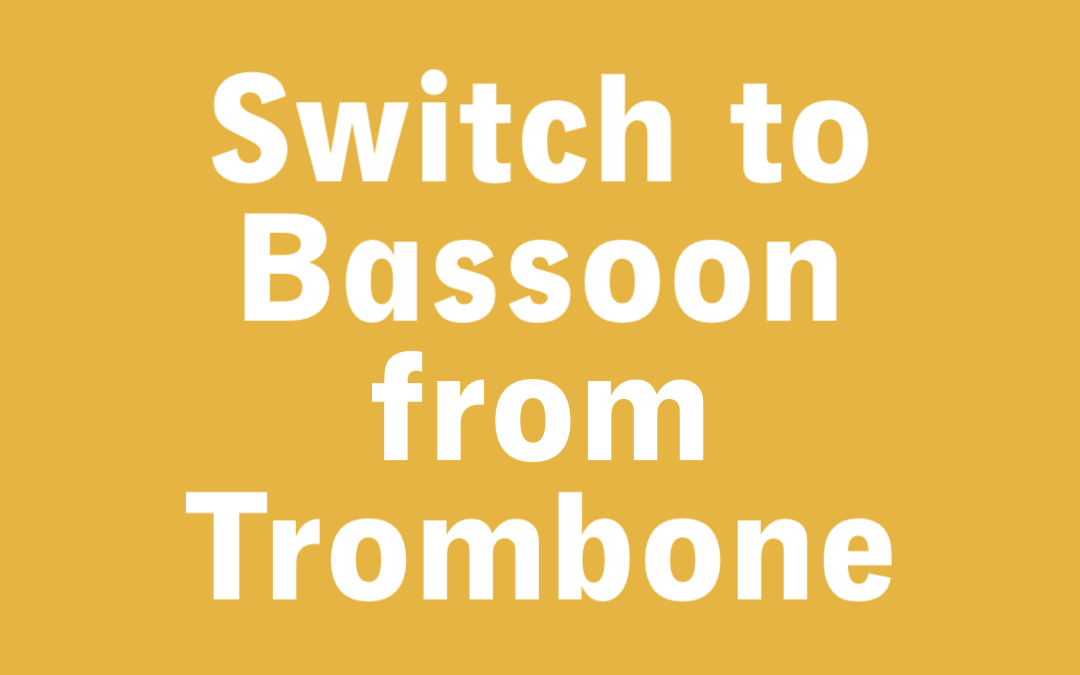Although the trombone is a brass instrument, it shares a lot in common with the bassoon. Both instruments are in the same key, read in the bass clef, and require a similar amount of air to play. Students who switch from the trombone to the bassoon may not have too much difficulty getting started. However, there are a few key areas that the student will need to adjust to: reeds, embouchure, articulation, and holding the instrument. Watch the video below and keep reading to learn how to overcome these initial challenges!
Reeds (01:07)
Bassoon uses what is called a “double reed.” All this means is that there are two pieces of cane (type of wood) that vibrate together to make sound. You must soak your reeds completely in water for a couple minutes before trying to play on them. Make sure that you are changing the water out of your reed soaker container at least once a day. You will periodically need to purchase new reeds because yours will wear out over time, depending on how often you’re playing on them. When you are finished playing, be sure to store the reeds in a case or container that is NOT airtight. There needs to be some sort of ventilation so that the reeds do not become moldy with so much moisture.
Embouchure (02:51)
It is helpful to think about the mouth being like the opening of a drawstring bag that closes enough to create a round seal around the reed, but never pinches or bites the reed. Follow these steps to create a bassoon embouchure:
- Make a whistling face (or pretend like you can whistle). What this should do is push your lips slightly forward and bring the corners of your mouth in to create a round aperture.
- While you are making that whistling face, take your finger and roll your bottom lip just slightly over your bottom teeth to make a cushion for the reed to sit on.
- Put the reed in your mouth and bring your top lip just slightly forward in front of your bottom lip. This step may happen naturally when you make your whistling face, so you will want to use a mirror to determine what your embouchure looks like. The top lip simply acts as a cover to the top of the reed, so it doesn’t need to apply any pressure. The bottom lip is the primary support and cushion for the reed.
One of the things that makes the bassoon embouchure unique from other instruments is that it is very “tall” and open. In order to produce a good sound and avoid being sharp, there needs to be quite a bit of space in the oral cavity.
Articulation (03:59)
The tip of the bottom blade of the reed will make contact with just behind the tip of the top of the tongue. While tonguing, think about using a “doo” or “doh” syllable with the mouth shape. This helps to create enough space in the mouth and throat.
The most important thing to creating a good bassoon sound is the air support. The articulation lightly interrupts the air stream as you are playing, but it never stops the air completely. Practice tonguing on the reed by itself to better understand this concept.
Holding the Bassoon (05:20)
When switching to the bassoon, the student won’t be familiar with using a seat strap to play. Make sure that the seat strap is all the way to the front of the chair so that, if you are looking at the player from the side, the bassoon is nearly perpendicular to the ground. In this way, the seat strap will hold the majority of the weight of the bassoon and the player simply needs to balance it.
Watch the video to see where to position your fingers in their “home base” positions, and you will be ready to start learning some fingerings!
While these tips that I’ve outline are a great place to start playing the bassoon, they are by no means a comprehensive guide. Subscribe to my email list below to keep up to date on future videos, blogs, and other useful information for learning the bassoon.


Recent Comments